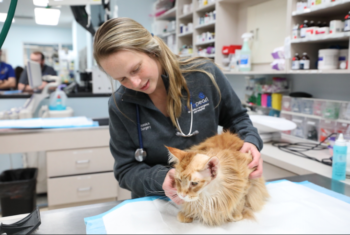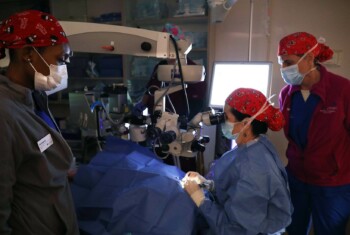Living with Three Limbs
 Limb amputation sounds like a scary and life-changing event. But for animals with debilitating and painful disease or trauma of the leg, amputation can sometimes be the best decision for quality of life and pain relief.
Limb amputation sounds like a scary and life-changing event. But for animals with debilitating and painful disease or trauma of the leg, amputation can sometimes be the best decision for quality of life and pain relief.
It may surprise you to learn that most pets with three legs live perfectly happy and normal lives. Dr. Philippa Pavia, a board-certified veterinary surgeon and medical director at BluePearl Downtown New York City, answers the frequently asked questions about three-legged pets and limb amputation.
Why do some pets need limb amputation?
The most common reason for limb amputation in pets is cancer that affects the leg, Dr. Pavia said. Osteosarcoma, a cancer of the bone, can form in the leg and cause tremendous pain and lead to fractures. Severe trauma that involves multiple fractures and/or the loss of a significant amount of soft tissue is another common reason for amputation.
How does having three limbs affect pets’ quality of life?
According to Dr. Pavia, quality of life actually improves after amputation because the source of pain and discomfort is removed. In many cases, the pet is already used to shifting his weight to three limbs because the affected leg was too painful or sensitive to walk on.
“There are a lot of misconceptions about limb amputation in pets,” said Dr. Pavia. “Most pets do remarkably well with only three legs and quality of life greatly improves once they are no longer in pain.”
How does limb amputation recovery compare between pets and humans?
Compared to human limb amputation, pets have a much easier time with recovery. This is largely because of their anatomy. After amputation, pets still have three legs whereas humans only have one. Pets adjust quickly to redistributing their force to three legs. Also, pets do not suffer from psychological trauma of limb loss like humans do. Many pets with three legs are unaware they are any different.
In people, partial limb amputations are more common, and prosthetic limbs are more often required to regain function. In our patients, this is rarely necessary, though in special circumstances this can be performed in collaboration with a specialized veterinary prosthetics expert.
Are certain types of pets better candidates for amputation surgery?
Most cats and dogs adapt well to living with three legs, but some types of pets have an easier time with recovery, Dr. Pavia said. The agile nature of cats allows them to adjust quickly. In dogs, generally smaller and younger dogs have an easier time adjusting. Dogs with arthritis or neurological complications may have a harder time adapting to three legs.
How does front or hind limb amputation affect my pet?
It is slightly easier for cats and dogs to recover from hind limb amputation, as they carry 60 percent of their body weight on their front legs, but the vast majority of patients with front limb amputations walk well without assistance.
What should I know about surgery and the recovery period?
Even if the tumor or trauma is lower down in the limb, your surgeon will likely remove the entire leg, because it is not healthy to leave a remaining bone unless it still has a job, according to Dr. Pavia. In special circumstances, a partial limb amputation can be performed for the use of a limb prosthesis.
The surgery itself usually involves just a one-night stay in the hospital with 24-hour monitoring by veterinary staff and medications for post-operative pain management. Most pets are walking around the next day and cleared to go home. The recovery period is surprisingly short, and post-surgery complications, including fluid buildup and infection, are typically not common with proper home care.
What do I need to consider with home care?
Pets with three legs do better on floors with traction, so wood and tile floors are not as preferable as carpet. If your home has more slippery floors, consider laying down some yoga mats so your pet can walk more comfortably. It’s also important to make sure your pet does not become overweight or obese. Also, it’s a good idea to talk with your veterinarian about choosing a harness that is best suited for your three-legged pet.
Where can I learn more about life with three-legged pets?
There are many online support groups and blogs involving the community of owners of pets with three legs, commonly referred to as “tripods.” Also, ask your surgeon to connect you with other pet parents who have elected amputation for their pets.
“The best advice I have for pet owners considering amputation surgery is to talk with other owners of three-legged pets,” said Dr. Pavia. “They can offer a lot of great tips and it is comforting to hear the experiences of others.”


